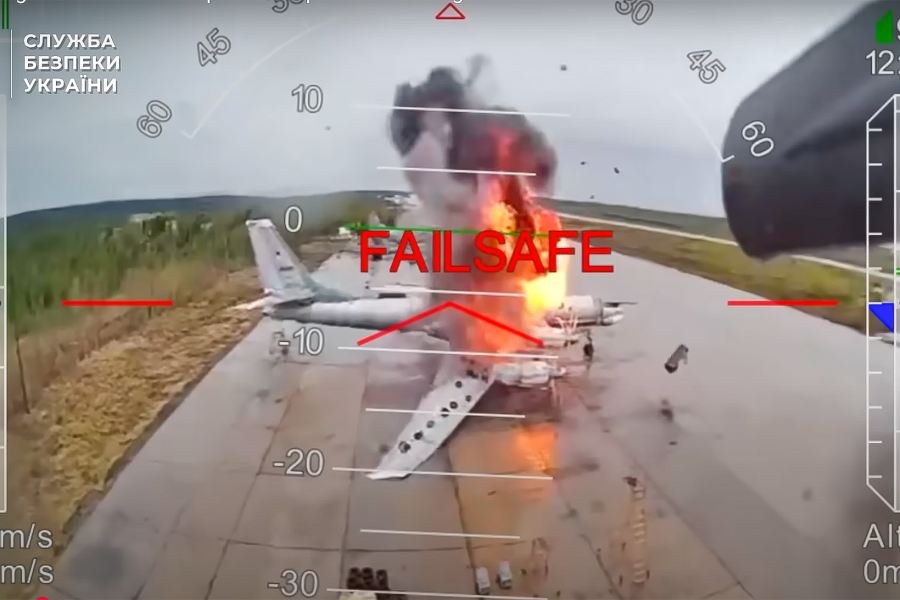Ukraine’s “Operation Spiderweb” attack on Russian air bases, which destroyed unprotected bombers at rest on their ramps, is reshaping how U.S. thinkers approach defending military bases and the U.S. homeland.
The Spiderweb attack launched scores of drones from inside Russia, a surprise that caught the Russian air force entirely unprepared and unable to fend off short-range strikes. That has implications for how the Air Force defends its bases—and even which threats America’s future Golden Dome defense shield must guard against.
“A lot of people were not as stressed about [unmanned aerial systems attacking the U.S.] because they felt like the tyranny of distance” would be sufficient to stop such threats, said Doug Jones, chief technology officer for Leidos’ Defense Sector. “They were not taking into account the … insurgency delivery of UASes.”
What Ukraine’s attack showed, Jones said, is that small UASes smuggled to a launch point near potential targets can overcome their inability to fly long distances in a short time and short-circuit conventional defenses.
“That says you can’t just do cruise missile and hypersonic defense for like, a Golden Dome-type scenario, or an integrated air and missile defense,” Jones said in response to questions from Air & Space Forces Magazine. “You have to also protect inside the country … in particular, [from] the threats that are going to come after the things you’re using to shoot things down.”
Just as medieval armies protected their most prized archers in battle to ensure those assets could strike deep behind enemy lines, a modern base defense—and potentially, Golden Dome—must also be built to protect its core assets, Jones said, citing the radars and missile batteries needed to fend off a long-range attack.
“What’s happened over the past six months has definitely made them look a little bit differently [at] what a real scenario looks like,” he said.
Leidos CEO Tom Bell does not see his company becoming “Mr. Golden Dome,” but he does see what described as a $4 billion to $5 billion addressable opportunity for the company in providing pieces of the Golden Dome puzzle.
“When it comes to the ground layer and air defense for counter-UAS, air defense against cruise missiles … to border surveillance, passive and active radars, the capabilities to know what’s happening over the horizon and around the borders of America, … the space layer and having pervasive understanding of what’s coming our way,” he said, Leidos has a lot to offer.
Affordable Mass vs. High-Priced Defense
That includes solving the overall riddle of what these defense systems need to encompass.
Leidos’ traditional expertise is in systems integration, data management, and related technologies, but the company has increasingly become a hardware provider through acquisitions and strategic initiatives, and its portfolio now includes missiles, uninhabited naval systems and more. The company sees opportunity in developing lower-cost cruise missiles—in the $300,000 range to answer the “affordable mass” needs voiced by the Pentagon, for example, as well as potential “tactical” hypersonic missiles with the goal of driving costs for such a weapon under $10 million.
But Jones said he’s also focused on the reverse: Finding the best way to defend against the low-cost mass now being fielded by adversaries. With low-end threats proliferating, however, Pentagon officials are eager to develop lower-cost solutions to counter them. The conflicts with Iran and Yemen have highlighted the disproportionate cost to defend against low end attacks: The U.S. has expended tens of millions of dollars worth of weapons to defeat Iranian-built weapons costing a fraction.
“Historically, we want to intercept things as far away as we can,” Jones said. “Which means you’re firing your most expensive, most exquisite assets at those things as far away as possible. In a situation where the adversary uses mass against you, you don’t have that luxury, because you’re going to run out of magazine depth of your higher end assets—what we’ve seen play out in the Red Sea and other places.”
Now U.S. planners should be asking: “How do I do weapon-target pairing from an optimized approach,” one that takes into account how much potential damage a given target can inflict, as well as the cost and value of the weapons available to counter those targets, Jones said. “How do I balance the risk of my resource utilization so I have the most successful overall engagement?”
Here, Leidos sees opportunity to develop automated decision engines that can appropriately orient the most expensive Patriot or THAAD missiles to the most dangerous threats, like hypersonic and ballistic missiles, intermediate weapons to counter cruise missiles, and close-in weapons to counter small UASes with the least destructive power.
“You want to use those things that have high depth of magazine and low cost per intercept for the closer engagements,” Jones said. “We’re doing a lot of research in that area and a lot of partnership with the Air Force around that.”


